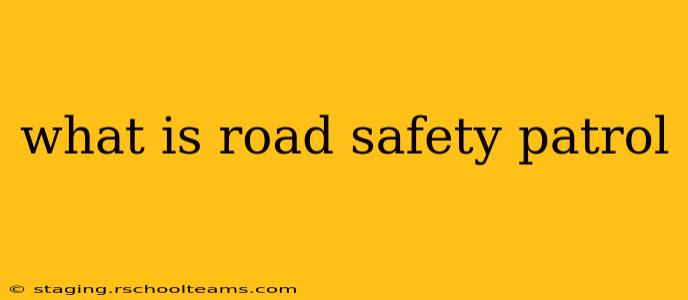Road Safety Patrol (RSP) programs are volunteer-based initiatives, typically run in schools, aimed at improving safety for students traveling to and from school. These programs empower students to actively participate in promoting safe pedestrian and cyclist practices within their communities. While the specifics can vary slightly depending on location and school, the core mission remains consistent: enhancing road safety for children.
What are the responsibilities of a Road Safety Patrol member?
RSP members take on various responsibilities, all centered around ensuring the safety of their fellow students. Their duties often include:
- Controlling pedestrian crossings: This involves guiding students safely across roads, especially at busy intersections near the school. They often use signage or patrol vests for visibility.
- Monitoring traffic: RSP members observe traffic flow and alert students to potential hazards.
- Educating peers: They act as role models, reminding students about important road safety rules and good pedestrian practices.
- Reporting incidents: Should any incidents or near-misses occur, they are responsible for reporting them to school authorities.
How do I join a Road Safety Patrol?
Joining a Road Safety Patrol typically involves expressing interest to your school. Many schools have an application process, possibly involving an interview or a short training session. Requirements can vary, but typically involve a certain age, academic standing, and a commitment to responsibility.
What training do Road Safety Patrol members receive?
The training provided to RSP members usually covers:
- Road safety rules and regulations: This includes understanding traffic signals, pedestrian right-of-way, and safe crossing techniques.
- Communication and leadership skills: Patrol members learn how to effectively communicate with their peers and other drivers.
- Emergency procedures: Training may include how to handle incidents and report them appropriately.
- Safe patrol practices: This includes instructions on how to safely and effectively perform their duties while remaining visible to drivers and other pedestrians.
What are the benefits of being a Road Safety Patrol member?
Participation in an RSP program offers numerous benefits, including:
- Developing leadership and responsibility skills: RSP members gain valuable experience in leadership and taking responsibility for the safety of others.
- Improving community awareness: They become more aware of road safety issues within their community.
- Gaining valuable experience: This experience can be beneficial for future endeavors.
- Making a positive contribution: They contribute directly to the safety and well-being of their school community.
Are there different types of Road Safety Patrol programs?
While the core principles remain the same, variations in program structure and specifics exist across different locations and schools. Some programs may focus more heavily on pedestrian safety, others on cyclist safety, and some may incorporate elements of both. The level of training and responsibilities might also vary.
What age is appropriate for Road Safety Patrol?
The appropriate age for participation in an RSP program varies by location and school policy. However, it’s typically aimed at older elementary school students and middle schoolers who have demonstrated maturity and responsibility.
How can I support Road Safety Patrol?
Support for RSP programs can come in many forms. Parents can encourage their children to participate. Schools can provide adequate training and resources. The community can help raise awareness about the importance of road safety and the role of RSP members.
In conclusion, Road Safety Patrols are vital community initiatives empowering students to actively improve road safety in their schools and surrounding areas. They're a testament to the power of youth involvement in creating safer communities.
